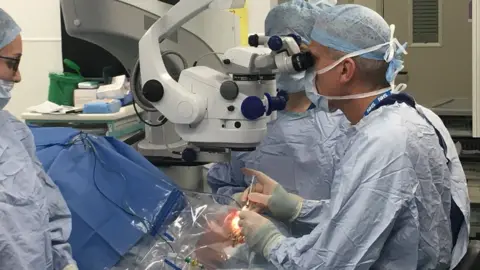Gene therapy first to 'halt' most common cause of blindness
 Fergus Walsh
Fergus WalshA woman from Oxford has become the first person in the world to have gene therapy to try to halt the most common form of blindness in the Western world.
Surgeons injected a synthetic gene into the back of Janet Osborne's eye in a bid to prevent more cells from dying.
It is the first treatment to target the underlying genetic cause of age-related macular degeneration (AMD).
About 600,000 people in the UK are affected by AMD, of whom 350,000 are severely sight impaired.
Janet Osborne told BBC News: "I find it difficult to recognise faces with my left eye because my central vision is blurred - and if this treatment could stop that getting worse, it would be amazing."
The treatment was carried out under local anaesthetic last month at Oxford Eye Hospital by Robert MacLaren, professor of ophthalmology at the University of Oxford.
He told BBC News: "A genetic treatment administered early on to preserve vision in patients who would otherwise lose their sight would be a tremendous breakthrough in ophthalmology and certainly something I hope to see in the near future."
Mrs Osborne, 80, is the first of 10 patients with AMD taking part in a trial of the gene therapy treatment, manufactured by Gyroscope Therapeutics, funded by Syncona, the Wellcome Trust founded investment firm.
What is AMD?
The macula is part of the retina and responsible for central vision and fine detail.
In age-related macular degeneration, the retinal cells die and are not renewed.
The risk of getting AMD increases with age.
Most of those affected, including all those on this trial, have what is known as dry AMD, where the decline in sight is gradual and can take many years.
Wet AMD can develop suddenly and lead to rapid vision loss but can be treated if caught quickly.
 Fergus Walsh
Fergus WalshHow does gene therapy work?
As some people age, genes responsible for the eye's natural defences start to malfunction and begin destroying cells in the macula, leading to vision loss.
An injection is made at the back of the eye, which delivers a harmless virus containing a synthetic gene.
The virus infects the retinal cells and releases the gene.
This enables the eye to make a protein designed to stop cells from dying and so keep the macula healthy.

The early stage trial, at Oxford Eye Hospital, is primarily designed to check the safety of the procedure and is being carried out in patients who have already lost some vision.
If successful, the aim would be to treat patients before they have lost any sight, in a bid to halt AMD in its tracks.
That would have major implications for patients' quality of life.
It is too early to know if Mrs Osborne's sight loss in her left eye has been halted but all those on the trial will have their vision monitored.
Speaking at home, she told BBC News: "I still enjoy gardening with my husband, Nick, who grows a lot of vegetables.
"If I can keep peeling and cutting the veg, and retain my current level of independence, it would be absolutely wonderful."
There is already a successful gene therapy treatment for another rare eye disorder.
In 2016, the same team in Oxford showed that a single injection could improve the vision of patients with choroideremia, who would otherwise have gone blind.
And, last year, doctors at Moorfields Eye Hospital, in London, restored the sight of two patients with AMD by implanting a patch of stem cells over the damaged area at the back of the eye.
It is hoped that stem cell therapy could help many people who have already lost their sight.
But the Oxford trial is different because it aims to tackle the underlying genetic cause of AMD and might be effective in stopping the disease before people go blind.
Follow Fergus on Twitter.
